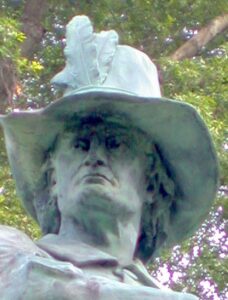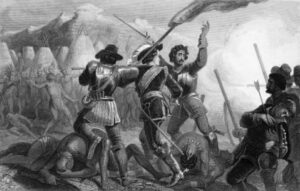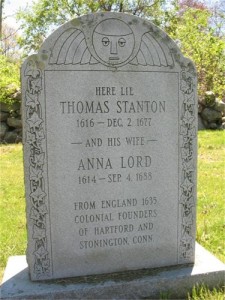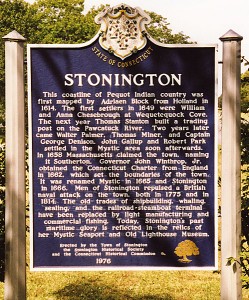Pequot war
 Captain John Mason was an English-born settler, soldier, commander, and Deputy Governor of the Connecticut Colony. While most people want to be remembered for the great things they did during their lives, Captain Mason will always be remembered for something else…being the leader of the massacre of the Pequot Tribe of Native Americans in southeast Connecticut. The group, led by Mason was a group of Puritan settlers and Indian allies, who combined to attack a Pequot Fort in an event known as the Mystic Massacre. The Mystic Massacre took place on May 26, 1637, during the Pequot War, when Connecticut colonizers and their Narragansett and Mohegan allies set fire to the Pequot Fort near the Mystic River. With the fire raging, they shot anyone who tried to escape the wooden palisade fortress, effectively murdering most of the village. In all, there were between 400 and 700 Pequot civilians killed during the massacre. The only Pequot survivors were warriors who were away in a raiding party with their sachem (chief), Sassacus.
Captain John Mason was an English-born settler, soldier, commander, and Deputy Governor of the Connecticut Colony. While most people want to be remembered for the great things they did during their lives, Captain Mason will always be remembered for something else…being the leader of the massacre of the Pequot Tribe of Native Americans in southeast Connecticut. The group, led by Mason was a group of Puritan settlers and Indian allies, who combined to attack a Pequot Fort in an event known as the Mystic Massacre. The Mystic Massacre took place on May 26, 1637, during the Pequot War, when Connecticut colonizers and their Narragansett and Mohegan allies set fire to the Pequot Fort near the Mystic River. With the fire raging, they shot anyone who tried to escape the wooden palisade fortress, effectively murdering most of the village. In all, there were between 400 and 700 Pequot civilians killed during the massacre. The only Pequot survivors were warriors who were away in a raiding party with their sachem (chief), Sassacus.
Prior to the massacre, the Pequot tribe were the dominate Native American tribe in southeast Connecticut, but  with the massacre, came the end of an era where that was concerned. The massacre was brutal and heinous and should have been met with severe punishment, but at that time in history, the Native Americans were not particularly valued among the people of the colonies. In fact, the Native Americans were probably viewed as the intruders, and not the natives. As more and more Puritans from Massachusetts Bay spread into Connecticut, the conflicts with the Pequots increased. The tribe centered on the Thames River in southeastern Connecticut, and by the spring of 1637, the Pequot tribe killed 13 English colonists and traders. That was when Massachusetts Bay Governor John Endecott organized a large military force to punish the Indians, who were only trying to protect what they saw as theirs. On April 23, 1637, with pressure mounting, 200 Pequot warriors responded defiantly to the colonial mobilization by attacking a Connecticut settlement, killing six men and three women and taking two girls away.
with the massacre, came the end of an era where that was concerned. The massacre was brutal and heinous and should have been met with severe punishment, but at that time in history, the Native Americans were not particularly valued among the people of the colonies. In fact, the Native Americans were probably viewed as the intruders, and not the natives. As more and more Puritans from Massachusetts Bay spread into Connecticut, the conflicts with the Pequots increased. The tribe centered on the Thames River in southeastern Connecticut, and by the spring of 1637, the Pequot tribe killed 13 English colonists and traders. That was when Massachusetts Bay Governor John Endecott organized a large military force to punish the Indians, who were only trying to protect what they saw as theirs. On April 23, 1637, with pressure mounting, 200 Pequot warriors responded defiantly to the colonial mobilization by attacking a Connecticut settlement, killing six men and three women and taking two girls away.
 Then on May 26, 1637, everything exploded when, two hours before dawn, the Puritans and their Indian allies marched on the Pequot village at Mystic, slaughtering all but a handful of its inhabitants. Following that attack, Captain Mason attacked another Pequot village on June 5, 1637, this one near what is now Stonington, and again the Indian defenseless inhabitants, were defeated and massacred. In a third attack on July 28, 1637, Mason and his men massacred a village near what is now Fairfield, and the Pequot War finally came to an end. Most of the surviving Pequot were sold into slavery, though a handful escaped to join other southern New England tribes.
Then on May 26, 1637, everything exploded when, two hours before dawn, the Puritans and their Indian allies marched on the Pequot village at Mystic, slaughtering all but a handful of its inhabitants. Following that attack, Captain Mason attacked another Pequot village on June 5, 1637, this one near what is now Stonington, and again the Indian defenseless inhabitants, were defeated and massacred. In a third attack on July 28, 1637, Mason and his men massacred a village near what is now Fairfield, and the Pequot War finally came to an end. Most of the surviving Pequot were sold into slavery, though a handful escaped to join other southern New England tribes.
 In trying to connect the Stanton side that exists through my dad’s half brother, Norman Willis Spencer, to the Stanton side that exists in Bob’s family through his grandma, Nettie Noyes Knox, I have come up with some interesting information. While I have not made the connection that I’m almost certain exists between the two sides, I did find out that within the Noyes side of the family, there is a Stanton family member who was of some significance to America too. His name was Thomas Stanton, and he was Bob’s 7th great grandfather. There are many ways for a person to have a degree of influence on American history, or history of any nation. Some people become kings or presidents. Others might have been great warriors, while still others might have made some great discovery.
In trying to connect the Stanton side that exists through my dad’s half brother, Norman Willis Spencer, to the Stanton side that exists in Bob’s family through his grandma, Nettie Noyes Knox, I have come up with some interesting information. While I have not made the connection that I’m almost certain exists between the two sides, I did find out that within the Noyes side of the family, there is a Stanton family member who was of some significance to America too. His name was Thomas Stanton, and he was Bob’s 7th great grandfather. There are many ways for a person to have a degree of influence on American history, or history of any nation. Some people become kings or presidents. Others might have been great warriors, while still others might have made some great discovery.
Thomas Stanton was a trader and an accomplished Indian interpreter and negotiator in the colony of Connecticut. He is first noted in historical records as an interpreter for John Winthrop Jr in 1636. He fought in the Pequot War, which took place between 1634 and 1638. He nearly lost his life in the Fairfield Swamp Fight in 1637. In 1638 he was a delegate at the Treaty of Hartford, which ended the war. In 1643, the United Colonies of New England appointed Stanton as Indian Interpreter.
He began a close alliance with the Thomas Lord family, who may have been friends from England and who had recently emigrated from Towcester, England. He married Thomas Lord’s daughter, Anna Lord, about 1636 and went into a merchant business alliance with Richard Lord. Some of Thomas’ land transactions involved serious difficulties, because people often sold and resold land without obtaining a clear title. An Indian sachem gave Quonochontaug to Stanton, but did the chief really own all of this land? A Stanton tract might overlap a tract claimed by another settler. These and other transactions like them, resulted in lengthy and costly litigation. Questions about the ownership of some of Stanton’s land and ambiguities in the will led to years of family and legal fighting.
But, probably the biggest claim to fame that Thomas Stanton had was that he was one of the four founders of Stonington, Connecticut, and one of the first settlers of Hartford, Connecticut. The present territory of Stonington was part of lands that had belonged to the Pequot people, who referred to the areas making up Stonington as Pawcatuck and Mistack. It was named  “Souther Towne” or Southerton by Massachusetts in 1658. It became part of Connecticut in 1662 when Connecticut received its royal charter. Southerton was renamed “Mistick” in 1665 and again renamed Stonington in 1666. Thomas Miner, Walter Palmer, William Chesebrough and Thomas Stanton were its four founders.
“Souther Towne” or Southerton by Massachusetts in 1658. It became part of Connecticut in 1662 when Connecticut received its royal charter. Southerton was renamed “Mistick” in 1665 and again renamed Stonington in 1666. Thomas Miner, Walter Palmer, William Chesebrough and Thomas Stanton were its four founders.
Upon Thomas death on Dec 2,1677, his will could not be located, and legal battles concerning the distribution of his property continued for years. When his wife, Anna died 11 years later, his estate was still unsettled. At some point, when going through some papers belonging to the city of Hartford, Connecticut, someone found the will, but that would not bring the estate to the point of being settled. The estate remained unsettled for a total of 40 years before the will was accepted and the estate settled. That is the kind of thing that can happen when money and land are involved.

